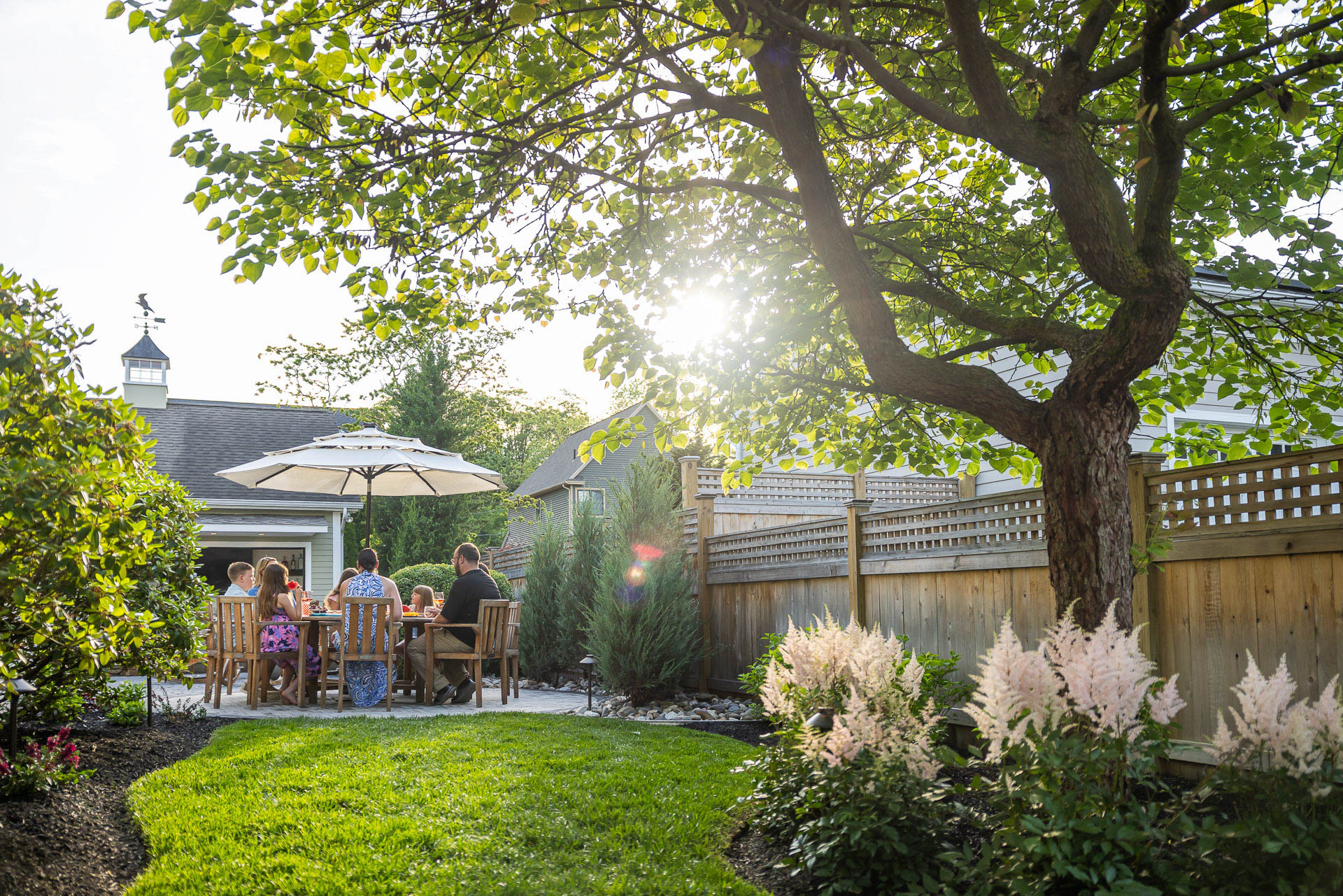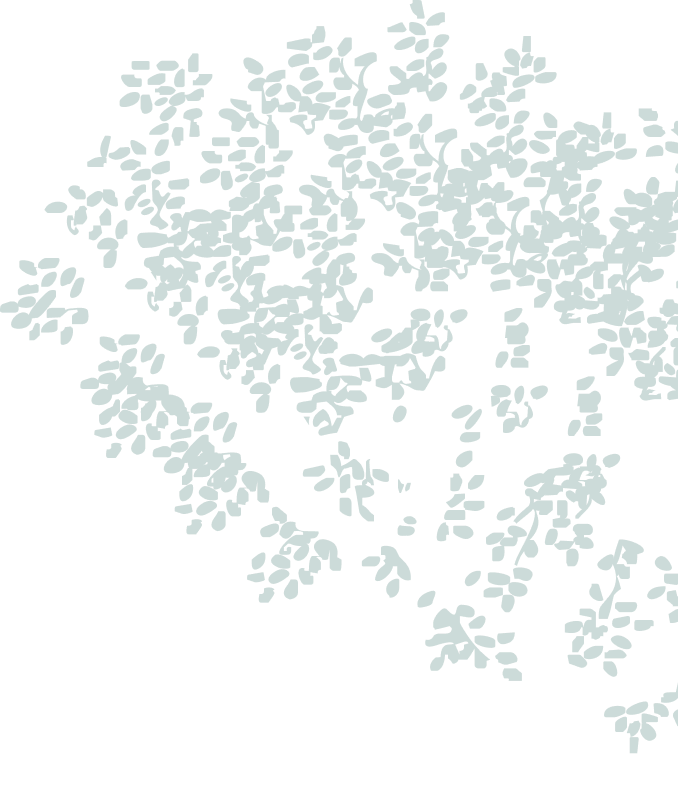
Written by: Carl Trinkle
23 min read
When it comes to transforming your outdoor space, it’s about so much more than adding a few plants here or there, some pops of color, or a DIY water fixture. For your space to feel refreshed, revitalized, and completely yours, it takes a thoughtfully designed custom outdoor environment.
The ultimate goal? It’s not just to spruce up your space and add curb appeal (though it will definitely do that). It’s to enhance your home, fit your lifestyle, and reflect your taste in a meaningful way.
Whether you’re looking to craft a serene backyard retreat, a front yard that wows the neighbors, or a full-scale luxury landscape, professional design is the key to achieving a space that’s as functional as it is beautiful.
In this guide, we’ll walk you through everything you need to know about landscape design in New York’s Capital Region – including areas like Saratoga Springs, Clifton Park, Albany, and Troy. Step by step, we’ll teach you the ins and outs of landscape design projects – from core element considerations to budgeting, planning, and choosing the right designer for your project.
By the end, you’ll know exactly what it takes to bring your outdoor vision to life and why partnering with an experienced company like Gallivan can take the hassle out of designing and building your luxury outdoor landscape.
Jump To:
What is Landscape Design?
Key Elements of Landscape Design
The Landscape Design Process
Must-Know Landscape Design Features
Choosing the Right Landscape Designer
Cost Considerations & Budgeting for Landscape Design
The Best Times of Year to Start a Landscaping Project
Frequently Asked Questions About Landscape Design
Working with a Professional Landscape Design Team
What is Landscape Design?
We could probably write the world’s longest love poem about landscape design. As a special team of landscape professionals with several landscape designers on staff, we feel extra passionate about the art and science of landscape design.
Essentially, landscape design is all about creating, planning, and installing outdoor spaces to maximize a landscape’s beauty, usability, and harmony with your home or commercial property.
Contrary to popular belief, landscape design goes far beyond simply planting flowers, adding lighting, or laying stone. A professional landscape designer considers the flow, function, aesthetics, purpose, maintenance, and overall feel of a space before, during, and after the design and installation process.
Landscape design involves thinking about:
- Functionality: Walkways, patios, and outdoor rooms that work for your lifestyle.
- Aesthetics: Color palettes, textures, and plantings that enhance your property’s curb appeal.
- Longevity & Seasonality: Selecting plants and materials suited to the Capital Region’s climate ensures your landscape thrives year after year.
- Curb Appeal & Value: A thoughtfully designed landscape can significantly increase your home’s market appeal and resale value.
- Maintenance & Upkeep: How complicated is it to protect the investment of landscape design after everything’s installed? How much time and money does it take to maintain that landscape design? Is that the right fit for the property?
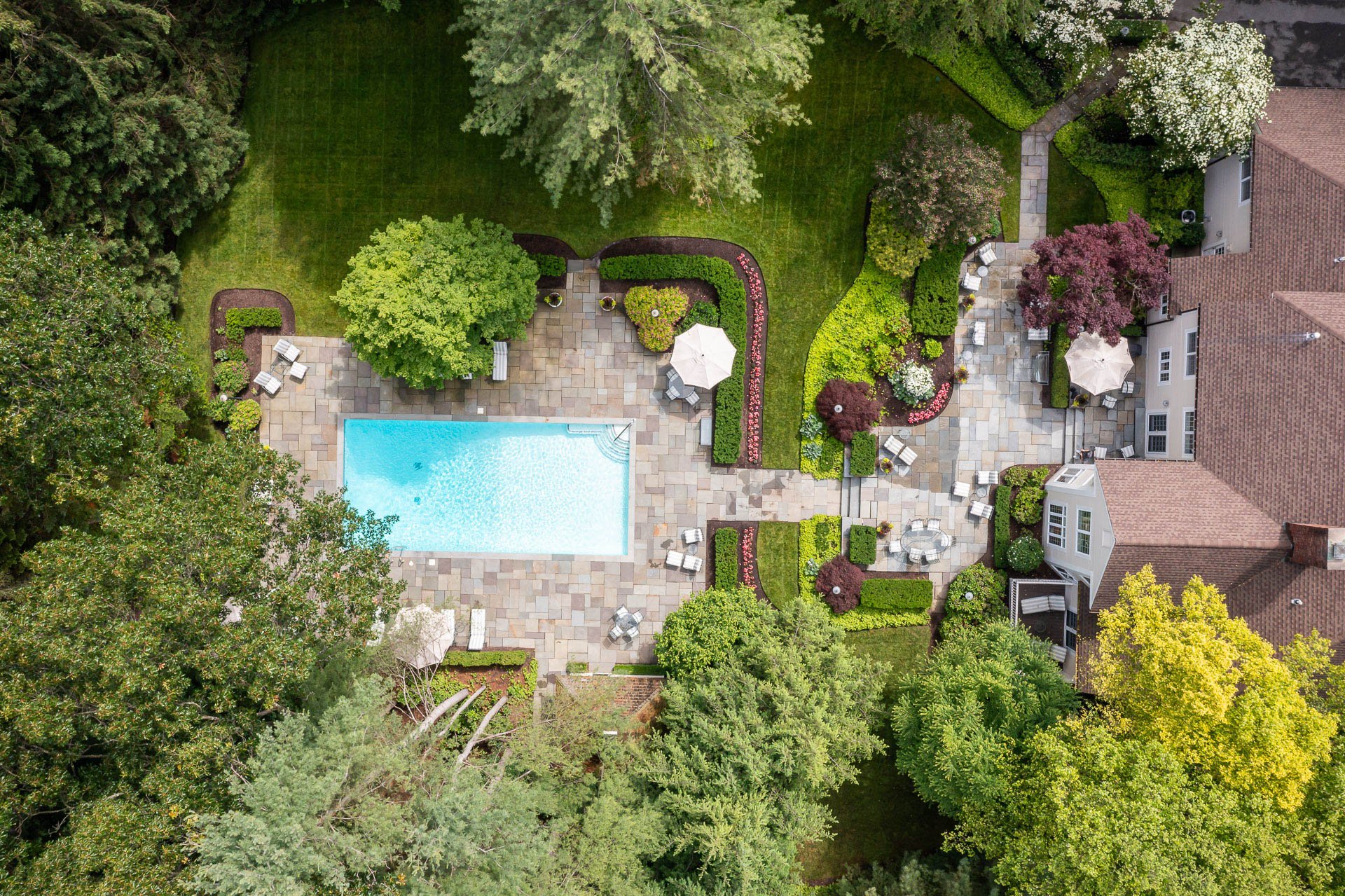
Why a Well-Designed Landscape Adds Value to Your Home
Investing in professional landscape design is about much more than creating a pretty yard and hoping it stays that way. At its core, it’s really all about enhancing your home, your lifestyle, and your long-term investment.
While many homeowners might be tempted to tackle landscaping as a DIY project, the truth is that a thoughtfully designed and expertly executed landscape delivers benefits that go far beyond aesthetics. Here are some ways a high-quality, tailored design can transform your property.
Boosts Your Property Value
A professionally designed landscape can increase your property’s market value by 10–15%, according to industry studies. But it’s not just about numbers – strategically planned landscapes make your home more inviting, functional, and memorable to potential buyers. Features like elegant walkways, cohesive plantings, and well-placed outdoor lighting create a sense of polish and luxury that elevates the overall perception of your property. Whether you plan to stay long-term or consider selling in the future, a high-end landscape is an investment that pays dividends.
Lifestyle Enhancement
Your outdoor space should feel and look like an extension of your home – and a professional landscape designer ensures it is. Imagine entertaining guests on a custom stone patio as the sun sets, or sipping coffee in a perfectly landscaped front garden every morning. Professional design takes your vision and transforms it into a functional, beautiful, and highly usable outdoor environment that works for your family, your schedule, and your personal style.
Reduce Long-Term Costs and Headaches
One of the most overlooked benefits of hiring a professional is avoiding costly mistakes that can result from DIY. Experienced landscape designers account for:
- Proper drainage to prevent water damage or erosion
- Soil health and preparation for long-term plant success
- Strategic plant placement for growth, shade, and seasonal appeal
- Material choices that balance durability, beauty, and maintenance
By planning ahead, a professional reduces the risk of replacing plants that fail, repairing improperly installed hardscape, or redoing sections of your yard. In other words, you’re not just paying for design, you’re paying for peace of mind and long-term savings.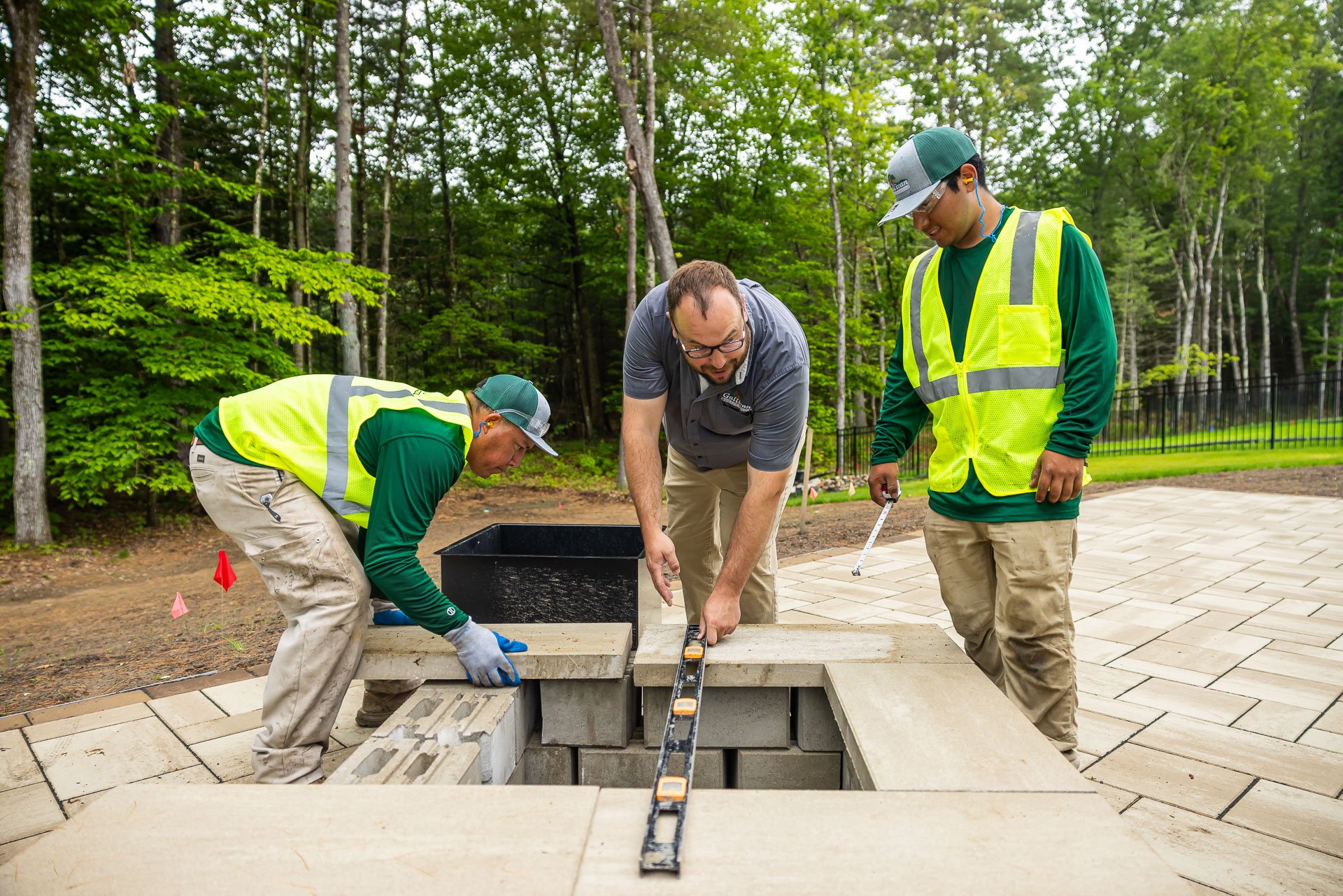
Create a Cohesive, Timeless Vision
Luxury landscaping isn’t about following the latest trend – though it can include trends you truly love. It’s really about designing a cohesive outdoor environment that complements your home and stands the test of time. A professional designer considers your home’s architecture, your property’s natural features, and your personal aesthetic to create a design that feels intentional and harmonious.
Key Elements of Landscape Design You Should Know
If the idea of creating a cohesive, intentional, and professional landscape design for your space is intimidating – you’re not alone. Working with a professional can help you sift through the must-haves, the nice-to-haves, and the not-right-for-our-space elements.
That said, it’s important to be familiar with some of the key elements of landscape design.
A well-designed outdoor space balances hardscape and softscape, includes thoughtful (and safe) lighting, and strategically uses plants to enhance your landscape’s flow.
Hardscaping vs Softscaping: What’s the Difference?
One of the first considerations any landscape designer should discuss with you is hardscape and softscape. It’s important to understand the difference and know when to use each.
- Hardscape refers to all the non-living, structural elements in your yard, such as patios, walkways, retaining walls, decks, pergolas, and driveways. These elements provide structure, define spaces, and create pathways for movement while adding visual interest and durability. A well-designed hardscape sets the foundation for a landscape’s overall flow and usability.
- Softscape includes all the living components, like trees, shrubs, flowering plants, lawns, groundcovers, and even seasonal plantings. These elements bring color, texture, and life to your landscape. Softscape creates contrast against hard surfaces, adds shade, provides privacy, and changes with the seasons to keep your yard feeling fresh and vibrant year-round.
A thoughtfully designed landscape integrates hardscape and softscape where they each make sense so that they complement one another rather than compete.
Picture a stone patio surrounded by layered garden beds and accented with a well-mulched garden path that looks beautiful yet ensures safe stepping. Sounds well balanced, right?
If you picture that stone patio without garden beds and a garden path without a touch of softscape, you can imagine that it might feel cold and uninviting. The same goes for an overly softscape-heavy yard – it has the potential to feel cluttered or lack cohesion.
The key to these elements is balance, balance, balance.
Plants, Trees, & Shrubs: Landscape Aesthetics
Plants are usually thought of as just decoration, but they’re actually a key structural and aesthetic element to any landscape.
Thoughtful planting design can guide movement, create focal points, and provide seasonal interest, all while supporting environmental sustainability if that’s a priority for you. Layered planting, using a mix of heights, textures, and bloom times, can also create depth, giving your landscape a dynamic, curated feel.
Professional landscape designers consider:
- Trees and Shrubs: These provide shade, privacy, and visual structure. Strategically placed trees can frame views, buffer noise, or create intimate outdoor rooms, while shrubs add texture, layers, and seasonal interest.
- Perennials and Annuals: In the Capital Region, layering bloom times, like peonies in spring, daylilies in summer, and asters in fall, keeps your landscape vibrant throughout the growing season.
- Native vs. Ornamental Plants: Native plants, like Black-eyed Susan, Eastern Redbud, and Switchgrass, thrive in the Capital Region’s climate, reducing maintenance needs and supporting local pollinators. These varieties are well-adapted to the area’s temperature swings and soil types, making them a sustainable, low-stress choice for homeowners in upstate New York.
 At the same time, professional landscape designers and installers consider plant growth patterns, soil quality, sun exposure, and drainage, ensuring each plant not only looks good but also thrives in its environment.
At the same time, professional landscape designers and installers consider plant growth patterns, soil quality, sun exposure, and drainage, ensuring each plant not only looks good but also thrives in its environment.
Outdoor Lighting: How it Can Enhance Your Space
The true unsung hero of landscape design? Landscape lighting installations.
Outdoor lighting goes so far beyond aesthetics because it improves safety, highlights architectural features, and transforms your yard into a magical, usable space after dark. In the Capital Region, where daylight hours shorten significantly in winter, proper outdoor lighting extends both safety and enjoyment year-round.
In other words, outdoor lighting is one of the most important factors in your design. Designers carefully plan lighting to serve multiple purposes:
- Pathway and Step Lighting: Ensures safe navigation through your yard at night, reducing trip hazards while subtly guiding visitors through outdoor spaces.

- Accent Lighting: Highlights plants, trees, water features, or architectural details, creating visual focal points and adding depth to your yard after sunset.

- Ambient Lighting: Soft lighting for patios, dining areas, or gathering spaces sets the mood for evening entertaining and relaxation.

- Energy-Efficient Options: Modern LED systems reduce energy use while providing flexible, durable solutions for year-round lighting. Many designers also incorporate timers and smart controls, allowing you to automate your lighting and maximize convenience and sustainability.
With thoughtful lighting, your landscape becomes a living space 24/7, extending your outdoor enjoyment and making your property feel luxurious, safe, and welcoming – even after the sun goes down.
The Landscape Design Process: How it Works & What to Know
Taking your landscape design dream to a landscape design reality might seem intimidating, but that's where Gallivan can help. Here’s a peek at our own landscape design process to show you how we work with our clients to bring their vision to life.
Step 1: Consultation & Vision Planning
Every landscape design journey begins with a detailed conversation. During this initial consultation, our team takes the time to understand:
- Your Lifestyle Needs: Whether you're looking to create a space for entertaining guests, a tranquil retreat for relaxation, or a safe play area for children, we tailor our designs to fit your unique requirements.
- Aesthetic Preferences: From modern minimalism to classic elegance or rustic charm, we discuss your style preferences to ensure the design reflects your personal taste.
- Site Assessment: Our experts evaluate your property's characteristics, including sunlight exposure, soil quality, and drainage patterns, to inform the design process. Whether dealing with heavy clay soil in Albany or sloped lots in areas like Delmar or Saratoga, our team tailors each design to local site conditions
 This foundational step sets the stage for a landscape that exceeds your expectations, considers your budget, and starts to put the pieces together of what your version of landscape success looks and feels like.
This foundational step sets the stage for a landscape that exceeds your expectations, considers your budget, and starts to put the pieces together of what your version of landscape success looks and feels like.
Step 2: Design & 3D Rendering
With your vision in mind, our in-house design team creates a custom plan tailored to your space. Utilizing advanced 3D rendering technology, we provide:
- Visualization of Spatial Flow: See how different elements interact within your space, ensuring a harmonious layout.
- Material and Plant Selection: Experiment with various materials and plant combinations to find the perfect match for your design.
- Alignment with Your Vision: Make adjustments as needed to ensure the final design aligns with your expectations before installation begins.
This step allows you to truly experience your future landscape before the first stone is laid.
Step 3: Material Selection & Budgeting
Choosing the right materials is crucial for both aesthetics and longevity. Materials like bluestone, granite, and frost-resistant pavers are ideal for the freeze-thaw cycles common in the Capital Region. When working with our team, we'll guide you through considerations like:
- Material Options: Select from a variety of high-quality stones, pavers, decking, and wall materials that suit your style and budget.
- Plant Selection: Choose plants that complement your design and thrive in your local climate.
- Budget Planning: We provide transparent pricing and discuss phased implementation options to fit your financial plan.
This phase ensures that your dream landscape is both beautiful and financially feasible – we’ll help you find the perfect balance of both.
Step 4: Installation & Project Execution
With the design finalized, our skilled craftsmen bring your vision to life. This phase includes:
- Site Preparation: Excavation, grading, and preparation of the site to ensure a solid foundation.
- Hardscape & Softscape Installation: Construction of patios, walkways, retaining walls, and planting of trees, shrubs, and flowers.
- Irrigation & Lighting Systems: Installation of efficient irrigation systems and strategically placed lighting to enhance functionality and ambiance.
- Quality Control: Our team ensures that every detail meets our high standards, delivering a landscape that is both stunning and durable.
 Throughout the process, we maintain clear communication, keeping you informed every step of the way.
Throughout the process, we maintain clear communication, keeping you informed every step of the way.
Step 5: Maintenance & Long-Term Care
A beautiful landscape requires ongoing care. Our maintenance plans are tailored to the Capital Region’s seasonal needs – from spring replanting to fall leaf cleanup and winter prep.
- Seasonal Cleanups: Preparing your landscape for changing seasons to maintain its beauty year-round.
- Pruning & Plant Care: Regular maintenance to promote healthy growth and longevity of plants.
- Irrigation & Lighting Maintenance: Ensuring systems are functioning efficiently to support your landscape's needs.
- Consultation Services: Ongoing advice and adjustments to keep your landscape evolving with your lifestyle.

Must-Know Landscape Design Features: The Most Popular Options
Landscape design isn’t just about which plants grow best where – it’s also about incorporating thoughtful features that can transform your yard into your vision (all while aligning with budget and goals).
As expert landscape designers in New York’s Capital Region, here are a few of the most common (and most adored) landscape design features we see – perhaps some that you should consider for your own landscape design.
Patios & Walkways: A Seamless Outdoor Flow
A well-designed patio or walkway does more than just provide a place to walk or sit. Patios create seamless flows between your home, the outdoors, and spaces on your property. Hardscaping materials such as natural stone, pavers, or decorative concrete can complement your home’s architecture, while curves, angles, and layered textures guide movement and draw the eye to focal points like gardens or water features.
Patios become outdoor living rooms, essentially – perfect for morning coffee, evening relaxation, or entertaining friends and family. Walkways, meanwhile, connect functional spaces while enhancing the overall aesthetic, creating a cohesive and inviting environment. Designers also consider accessibility and safety, incorporating lighting and non-slip surfaces so these areas can be enjoyed day and night.
Outdoor Kitchens & Fire Features: Design for Entertainment
This one is high on the list for families who love to entertain. These spaces can combine grills, countertops, sinks, and storage to bring full culinary functionality outside – making al fresco dining effortless and fun. Surrounding the kitchen with comfortable seating, dining areas, or a fire feature encourages lingering and connection.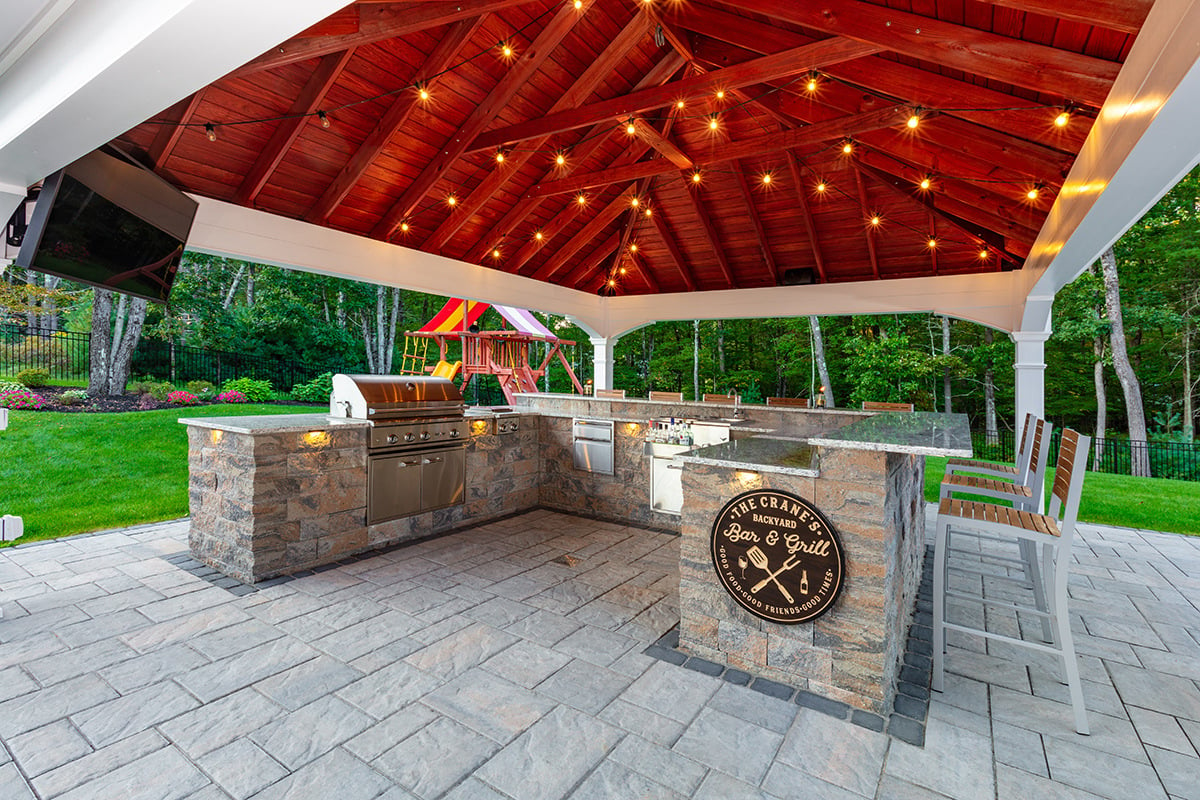
Fire pits and fireplaces extend your outdoor season, creating cozy gathering spots even on chilly evenings. The combination of heat, ambient lighting, and carefully chosen fuel type adds warmth, style, and sophistication to your backyard. Whether it’s casual family dinners or large social gatherings, outdoor kitchens and fire features transform your yard into a multi-functional, high-end entertaining space.
Pools & Water Features: Relaxation & Luxury
Water features can be a soothing feature for you and an elevating feature for your entire landscape. Our team ensures your pool or water feature is not only stunning in summer but also winterized for the Capital Region’s colder months.
Pools can be designed for swimming, lounging, or as a dramatic visual centerpiece, while fountains and ponds create calming ambient sounds and reflect light beautifully at night.
Strategically placed water features also increase property value, making your landscape not only enjoyable for everyday living but also a wise investment.
Designers carefully consider placement, safety, and maintenance to ensure your water elements remain both functional and stunning for years to come.
Sustainable Landscaping: Eco-Friendly Designs & Native Plants
Eco-conscious landscaping may have started as a trend, but it’s here to stay. This timeless strategy is a responsible approach that benefits both your property and the environment. Incorporating native plants, rain gardens, permeable paving, and water-efficient irrigation systems reduces water consumption, supports local ecosystems, and creates low-maintenance landscapes that thrive in New York’s Capital Region climate.
Sustainable designs don’t compromise on beauty or luxury. Thoughtful plant selections, creative layouts, and innovative systems ensure that your landscape looks vibrant year-round while minimizing environmental impact.
From energy-efficient lighting to composting areas and xeriscaping, sustainable features enhance the functionality, aesthetics, and longevity of your outdoor space.
Choosing the Right Landscape Designer in the Capital Region
If this guide has convinced you that a custom landscape design is a must – we’ve done our job right. Landscape design is a deeply personal thing. It combines your desire for a visual experience and a particular feeling on your property while challenging you to work within your budget.
Tack on the fact that many of your ideal features might seem out of your DIY reach, and a landscape design dream can quickly become an overwhelming nightmare.
That’s where professional designers and landscapers come in. Selecting the right landscape design company is one of the most important steps in creating a successful outdoor space. It’s about more than drawing up a plan – it’s about piecing everything together so it all comes out perfect for you.
If you’re not sure how to go about hiring the right team for you, this next section was written with you in mind.
Here’s what to what to look for in the perfect-fit landscape design company:
- Experience & Portfolio: A designer’s experience is often reflected in their portfolio. Ask yourself: do they have experience with high-end residential landscapes, luxury outdoor living spaces, or intricate hardscape and planting designs? Reviewing past projects gives you confidence that the designer can bring your vision to life with expertise and attention to detail. With projects completed in Saratoga, Loudonville, and Troy, our team is well-versed in the aesthetics and requirements of high-end Capital Region properties.
- Design Capabilities: Modern landscape design goes far beyond sketches. 3D renderings, custom site plans, and material mock-ups allow you to visualize the finished project before installation begins. This not only helps you understand the scale, flow, and aesthetics of your design but also enables you to make adjustments early, saving time and cost. Ask whether the designer provides options for custom features, sustainable solutions, and phased project planning to fit your lifestyle and budget.
- References & Reviews: Past client feedback is invaluable. A reputable landscape design company should be able to provide references or case studies highlighting their work, communication, and project management. Reading reviews or speaking directly with former clients gives insight into the designer’s reliability, creativity, and ability to deliver results on time and within budget.
Questions to Ask Before Hiring a Professional
There’s likely a never-ending list of things you should or could ask before hiring a design company, but we think these are the most important to cover:
What is your design philosophy?
Understanding their approach helps ensure your styles and expectations align.
Can you handle the full scope from design to installation?
Turnkey services often streamline the process and reduce the risk of miscommunication between designers and contractors.
How do you manage timelines and budgets?
Clear communication about project scheduling and costs is essential for a smooth, stress-free experience.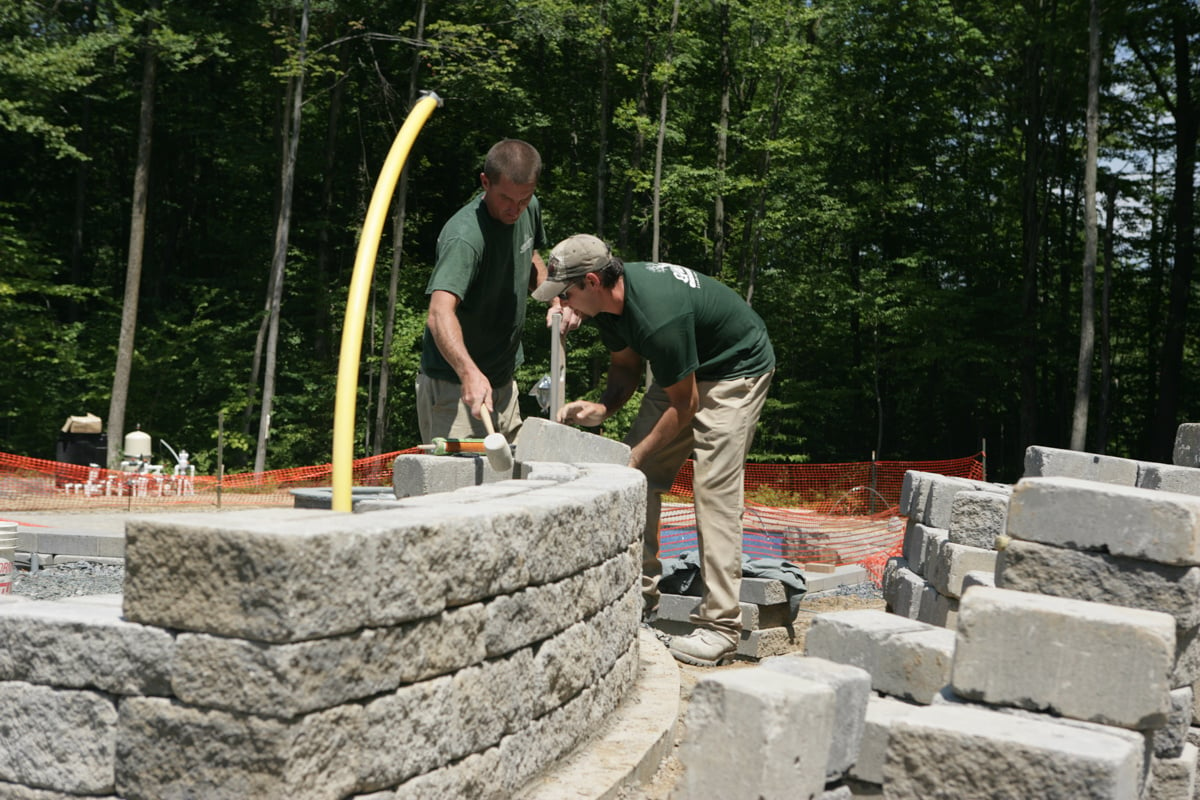
What’s the best time of year to start a landscaping project?
There isn’t one perfect season – each has its pros and cons in New York’s climate. Spring and early fall are typically ideal for planting and hardscape work, while summer is great for construction-heavy projects. The most important thing? Start planning 8–12 weeks before you’d like the installation completed. That gives enough time for design approvals, contracts, and scheduling.
How do you handle winter inquiries or off-season planning?
In the Capital Region, winter is often the design season. Most professionals use those colder months to work on concepts, finalize plans, and secure materials so everything is ready to install come spring. Some crews also perform limited installations year-round, weather permitting, so it’s worth asking what’s possible.
How long does a typical landscape project take?
Every project is different. A smaller refresh or planting might take just a few days, while complex outdoor living projects with patios, lighting, and irrigation can take several weeks or months. Your designer should provide a realistic timeline once the plan and scope are finalized.
Can you incorporate existing landscape features into a new design?
Absolutely! And it’s often a smart, sustainable choice. We often help Capital Region clients phase their projects strategically around seasonal windows – starting hardscapes in summer, planting in early fall, and lighting installation in late spring.
Do you provide guidance for maintaining the landscape post-installation?
A quality landscape partner doesn’t stop at installation. Ask if they provide detailed maintenance recommendations, or if they offer ongoing care packages. In New York’s seasonal climate, consistent maintenance and winter prep make a big difference in how your investment holds up.
Do you have any budgeting tips for phased projects?
If your vision is big but you’d like to tackle it in stages, ask about creating a master plan and budget. Many Capital Region homeowners approach their landscape as a long-term investment – often around 20–30% of their home’s value. A designer can help you phase the work into cohesive stages so each step fits into your broader vision.
Working With Gallivan: The Benefits You Should Know
We know this is the section where we talk about ourselves – we promise to do it honestly and humbly. When it comes to luxury landscape design, our in-house team is the best.
Our talented design team invests in the most advanced 3D rendering tools to help you see your stunning landscape come to life – before we ever touch your space.
More than that, we'll be with you every step of the way to ensure your design reflects your goals and fits your budget.
The Cost Considerations & Budgeting for Landscape Design
Understanding the costs associated with landscape design helps you plan for a project that balances what you’re dreaming of and your ideal budget.
Landscape design expenses vary depending on the size and scope of your project. However, there are some common elements that can impact your project’s cost:
- Size and Complexity: Larger properties or intricate designs naturally require more labor, materials, and planning time. Multi-level patios, water features, or extensive planting beds increase project scope.
- Choice of Materials and Plants: Premium stone, imported pavers, mature trees, and specialty plants enhance beauty but come at a higher cost. Choosing materials and plants that suit your climate can help balance quality and budget.
- Phased vs. Full-Scale Implementation: Some homeowners prefer to complete their landscape in stages, focusing first on high-impact areas like outdoor living rooms, patios, or pools. Phased planning allows for flexibility and budget management, while still building toward a cohesive final design.
- A Pro Tip From Our Team: Prioritize elements that provide the greatest visual impact and functional benefit, such as gathering spaces, focal gardens, or lighting. This ensures that each phase of your landscape delivers immediate enjoyment and value.
Our designers work closely with each client to maximize their return on investment without sacrificing style or quality, offering transparent cost estimates and tailored solutions that fit your vision and budget. With careful planning and professional guidance, a luxury landscape can be a timeless investment that enhances both your home and lifestyle
The Best Times of the Year to Start a Landscaping Project
Seasonal Considerations for Landscape Installation
There isn’t one single “perfect” season to begin a landscape project in New York’s Capital Region – each season offers its own advantages.
- Spring and early fall are ideal for planting, transplanting, and establishing new growth because of moderate temperatures and reliable rainfall.
- Summer is excellent for construction-heavy projects like patios, pools, or outdoor kitchens when the ground is dry and workable.
- Winter, though cold, is the perfect time to plan ahead, it’s when many Capital Region homeowners begin the design process so everything is ready for installation once the ground thaws.
Working with a professional designer early ensures your project is scheduled before peak season begins.
Planning Ahead: Spring & Summer Landscape Projects
The key to a smooth spring or summer installation is planning ahead. We recommend starting the design process 8-12 weeks before you’d like your installation completed.
That timeline allows for consultations, design revisions, budgeting, material selection, and scheduling, all before crews break ground.
Homeowners in Saratoga Springs, Albany, and Clifton Park often begin planning in winter or early spring so they can enjoy their finished spaces by summer. Whether it’s a new patio, garden redesign, or full outdoor living environment, early planning keeps your project on schedule and ensures the best availability of plants and materials.
Frequently Asked Questions About Landscape Design
How Long Does a Typical Landscape Project Take?
Project timelines vary depending on size and complexity. A small garden refresh or planting might take a few days, while larger projects (like patios, lighting, or full outdoor living spaces) can take several weeks to a few months.
Factors like weather, design revisions, and material availability also play a role. At Gallivan, we provide clear timelines and consistent communication so you always know what to expect at each phase of your project.
Can I Incorporate Existing Features into a New Design?
Absolutely! And often, that’s the smart choice. Incorporating existing landscape elements like mature trees, stone walls, or established garden beds can preserve your property’s character and reduce costs. Our designers frequently phase projects around what already works: reusing materials where possible, refreshing older spaces with new plantings, or connecting new hardscapes to existing patios. This approach ensures cohesion and sustainability while keeping your landscape’s best features intact.
How Do I Maintain My Landscape After Installation?
A professional landscape design is an investment. Want to protect that investment? Remember this – maintenance is what keeps it thriving.
Regular upkeep is essential in the Capital Region’s four-season climate, where plants, soil, and irrigation systems experience everything from heavy rain to snow and freeze-thaw cycles.
Our team recommends:
- Seasonal Cleanups: Spring prep and fall cutbacks to protect plant health.
- Pruning & Fertilizing: To encourage growth and prevent disease.
- Irrigation & Lighting Maintenance: Ensuring systems run efficiently.
- Professional Maintenance Plans: Gallivan offers seasonal maintenance programs tailored to your property and design, keeping your outdoor space beautiful, functional, and long-lasting year after year.
Ready to Work With a Professional Landscape Design Team?
Whether you’re dreaming of a relaxing backyard retreat, an elegant front-yard makeover, or a complete outdoor transformation, the Gallivan team is here to make it happen.
From custom design through professional installation and maintenance, we bring decades of Capital Region expertise to every project.
Fill out our consultation form today to be connected with our design team and begin your custom landscape project!
